The installation of bearings is a very important process, because it determines the life and performance of bearings.
Clearance between shaft and bore diameter of PTFE lined sleeve
This clearance should be 0~0.038mm (loose fitting) under oscillation motion, and 0.051~0.102mm (loose fitting) under rotating motion.
Housing fitting
PTFE lined sleeves require 0.013~0.051mm of tight fitting, and spherical bearings require a transition fit, -0.013mm tight to +0.013mm loose. Excessive tight fitting can influence the torque and clearance and leads to a possible fretting corrosion under dynamic load.
Roughness of Shaft Surface
The surface roughness shall be below 0.2μmRa. Rougher surface can shorten the sleeve life. Hardness shall be minimum 50HRC, and chrome plating is additionally recommended under extreme application conditions. Since PTFE type sleeves do not use any lubrication, corrosion resistance capacity shall be considered upon choosing the shaft.
Installing shaft in PTFE lined surface
The shaft shall be free of sharp edge and loose particles. The edge of the shaft shall be formed as Figures 19 or 20 with a minimum radius of 0.8mm or a 15°chamfer. Similarly, if a locking thread is to be incorporated in the shaft, extra caution is necessary in order to avoid damaging the Liner. The housing edge shall be also free of burr and sharpness. A hammer shall never be utilized to install a sleeve into a housing.
Figure 19 : R CHAMFER

Figure 20 : 15°CHAMFER
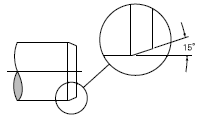
Installing sleeve into housing
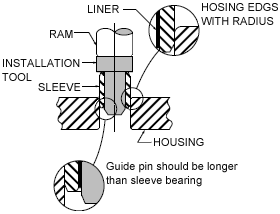
Appropriate method is shown in Figure 21. The installation tool guide pin should be longer than the sleeve bearing.
Installing spherical into housing
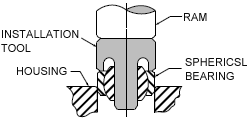
Figure 22 below shows the appropriate installation method. The ball should NEVER be pressed. The tight fitting spherical should be in a right angle to the housing. Inclining can easily damage spherical bearings.
V-staking, groove staking
V-staking is one of the method to fix a spherical bearing into a housing. A V-shaped groove is cut round the face of the race and the race material outside of this groove is pressed into a chamfer of housing with staking tool (Figure 23).
Appropriate staking pressure is given in Table 21, and the pressure shall be adjusted slightly depend on the staking appearance shown in Figure 25 and the axial proof load required. Excessive pressure reduces performance capacity and shortens the life of a bearing. After staking, a slight gap may occur in between race and housing chamfer. As long as this gap doesn't exceed 0.15mm, axial load capacity is not affected (Figure 23). V-staking does not disturb bearing performance as much as other methods can bear higher axial load. Bearing replacement is also easily done without damaging the housing.
Figure 23: V-staking
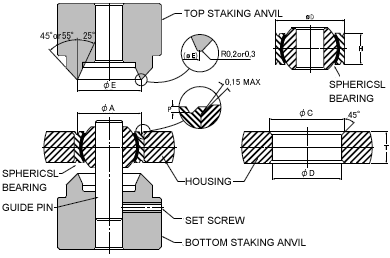
øE(Staking Tool Dia.)= øA + 0.1
øA:V-Groove Dia.
øC(Housing Chamfer Dia.)= øD + (T - H + 2P)
øD:Housing I.D. or Bearing O.D.
T:Housing Width
H:Race Width
P:V-Groove Depth
| V-Groove Type | V-Groove width X (mm) | Staking Load (N) { kgf } | |
|---|---|---|---|
| Steel Race (30-35HRC) | Al-Bz Race | ||
| A | 0.6 ~ 1 | 2647 × D { 270 × D } |
1569 × D { 160 × D } |
| B | 1 ~ 1.4 | 3138 × D { 320 × D } |
1961 × D { 200 × D } |
| C | 1.6 ~ 2 | 4412 × D { 450 × D } |
2745 × D { 280 × D } |
D : Spherical Outer Diameter (mm)
|
|||
Body staking
Housing is pressed into race chamfer with staking tool (Figure 24). Body staking can also advance axial load strength, however at the same time torque and clearance can be easily influenced. In addition, the housing needs to be replaced together with the spherical bearing as well. Both V-staking and body staking require large press-machine. There are other staking methods available (Roller staking, and Circumferential-Line staking) which require simple tooling.
Figure 24 : Body staking
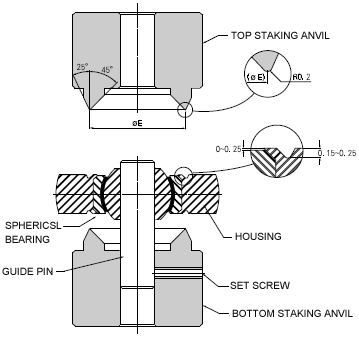
øE(Staking Tool Dia) = øD +(1.2 ~ 2.2)
øD:Housing I.D. or Bearing O.D.
Figure 25: Staking Appearance
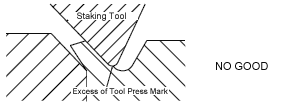
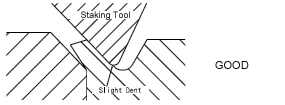
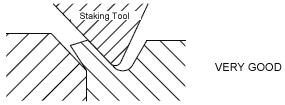
TOOL PRESS MARK
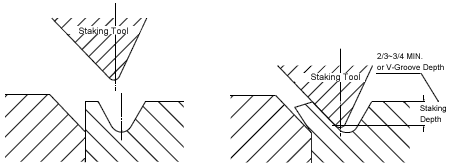
TOOL ING DEPTH
Related page
Engineering Information for Rod End Bearings
Technical Data
Contact Us
Please click the inquiry type below according to your question. Each product / sales representative will respond to you.